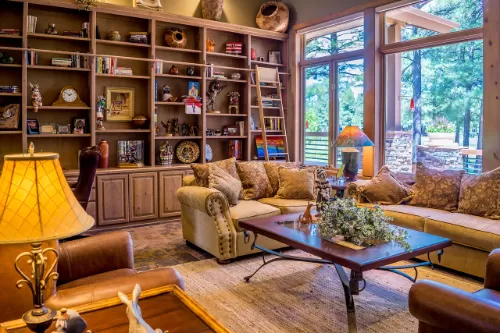

Click to Get Big Benefits

Start with One Item That Means Something
Instead of scrolling Pinterest for the perfect color palette, try this: pick one item that already means something to you. Maybe it’s your grandmother’s ceramic vase, a worn guitar from college, or that wild, hand-painted tile you found in Mexico. Let that item set the tone—emotionally and visually. It might inspire your color scheme, influence your layout, or simply remind you what matters most. This small, human anchor makes your design decisions feel less arbitrary and more authentic. After all, your home should feel lived in, not staged for a catalog.
Embrace the Mix—Because You’re a Mix, Too
You contain multitudes. Your furniture should, too. That means it’s perfectly okay—encouraged, even—to pair mid-century chairs with a Moroccan rug or hang a contemporary painting above an antique sideboard. The most interesting rooms aren’t matchy-matchy; they’re layered like a great outfit. Aim for contrast in textures (wood and linen, brass and leather), periods (vintage and new), and moods (structured and relaxed). When you embrace the mix, you’re giving your space permission to evolve—just like you do. Plus, nothing says confidence like breaking the “style rules” and making it work.
Paint with Personality, Not Fear
Color has the power to completely transform a space, but it also has the power to paralyze people. Here’s the thing: You don’t need to paint your walls neon green to be bold. Even a muted navy or soft terracotta can feel daring when paired thoughtfully. Try painting just one unexpected thing—like your ceiling, the back of a bookshelf, or your kitchen cabinets. Color should reflect how you want to feel in a room. Want calm? Think sage or warm whites. Want energy? Go citrus or cobalt. Want drama? Try charcoal or eggplant. There are no wrong answers—only shy ones.
Use Lighting Like a Movie Director
Lighting doesn’t just help you see—it sets the entire tone of a space. Harsh overheads can kill the vibe faster than a broken air conditioner. The key? Layers. Mix overhead fixtures with table lamps, floor lamps, and sconces. Use warm bulbs (2700K is your sweet spot) and dimmers wherever possible. Want a shortcut? Swap boring lamp shades for something that diffuses light softly. And don’t be afraid to get weird with light sources—string lights in glass jars or vintage lanterns can become sculptural moments. In a way, lighting is your home's emotional temperature. Keep it cozy.
Rethink the Room’s Job
We’re often told what rooms should be: a dining room for hosting, a guest room for... guests (that come once a year?). But what if your dining room became your art studio? Or your spare bedroom turned into a library-slash-gaming-den? Homes that reflect real lives—yours, not some imaginary dinner party host’s—feel more alive. Don’t be afraid to float furniture, ditch the TV, or throw a mattress on the floor if that’s what works. Form should follow function. But more importantly, function should follow fun. Let your needs—not social expectations—drive the design.
Put Something Weird in Every Room
Every room deserves a wink. Something that doesn’t quite make sense but delights you anyway. A disco ball in the bathroom. A taxidermy peacock in the foyer (okay, maybe scale it down). A vintage “Welcome to Vegas” sign above your desk. These unexpected details make rooms memorable and keep them from feeling like museum displays. Plus, they remind you not to take design—or yourself—too seriously. When done well, they spark conversation, laughter, and usually a “Wait, where did you get that?” Which, if we’re being honest, is the highest compliment in interior design.
Don’t Forget the Senses
Great interiors aren’t just visual—they’re sensory experiences. Think about how your space smells, sounds, and feels. A worn leather armchair that hugs you like an old friend. A candle that smells like a forest after rain. The rustle of linen curtains in the breeze. Even the way sunlight hits your hardwood floors at 4 p.m. These little details anchor you in the present and turn your home into a refuge. Invest in things that age well, sound right, and feel good against the skin. Your future self will thank you.
It’s Not About Perfection—It’s About Presence
At the end of the day, no one remembers if your throw pillows were seasonally appropriate. What they remember is how your home felt. Welcoming. Curious. Honest. The goal isn’t perfection—it’s presence. A well-designed room says, Someone lives here. Someone real. So give yourself permission to experiment, mess up, rearrange, and evolve. Take a picture now, then again in six months. Let your space grow with you. Because the best interiors aren’t static—they’re living, breathing reflections of you.
Conclusion
Your home is your habitat. It should energize you in the morning and calm you at night. It should reflect your values, your passions, your quirks. Good design doesn’t have to be expensive, trendy, or even “right”—it just has to feel like you. So go ahead, hang that painting too low, mix those colors, rescue that armchair from a thrift store. Design bravely. Live loudly. And most of all, trust your taste. You’re the only one who has to live in your space—make sure it makes you smile when you walk through the door.

All News
Others
- Terms of use
- Privacy Policy